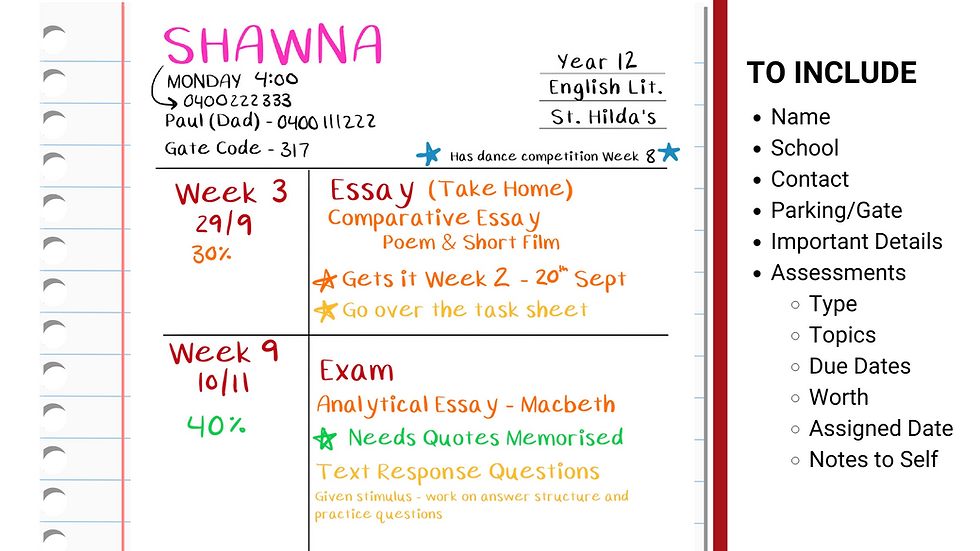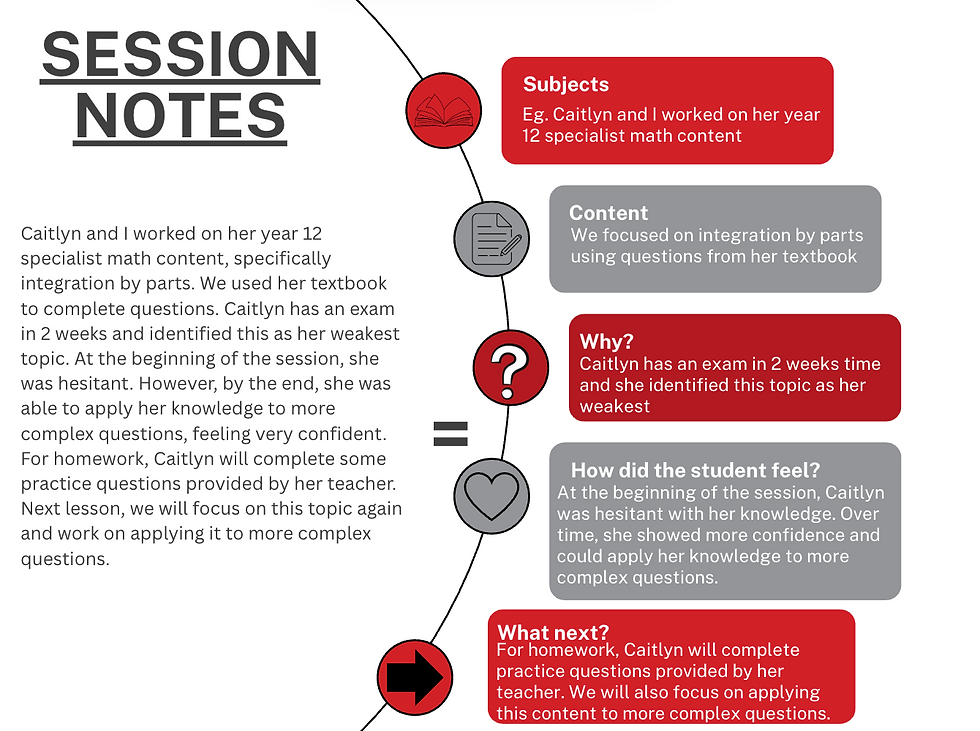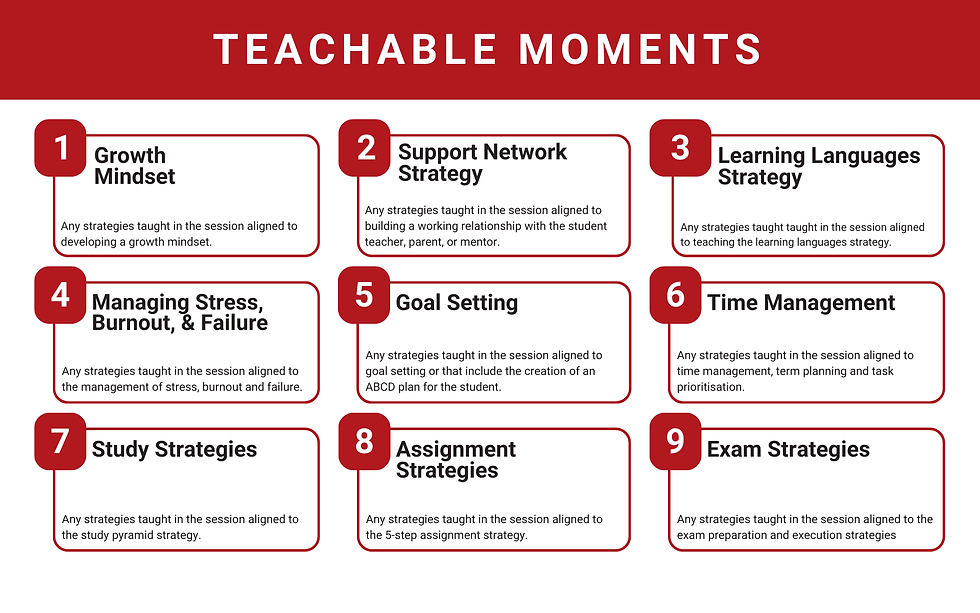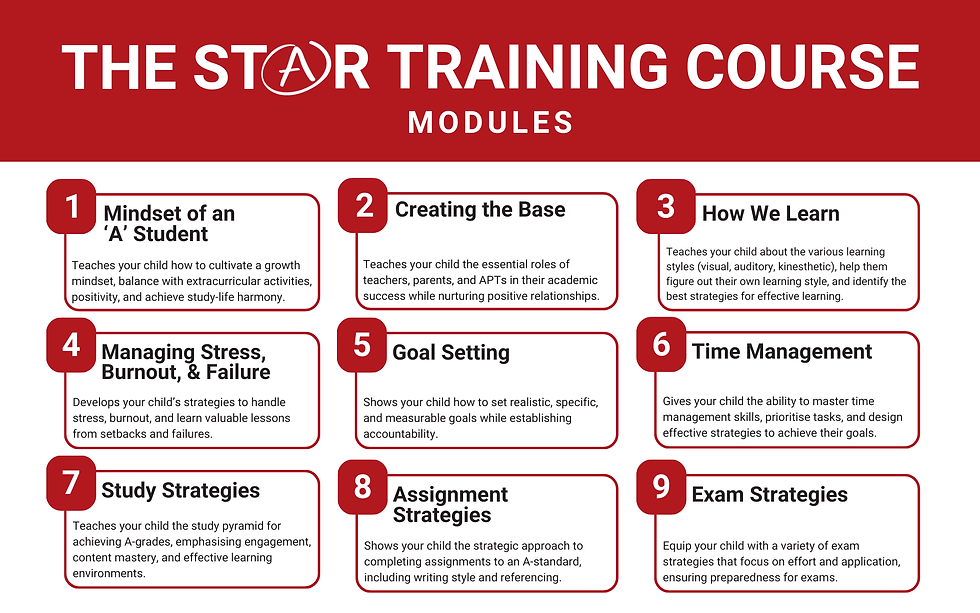Academic Personal Training Sessions
Session Preparation
At A Team Tuition, we understand the importance of being well-prepared to deliver effective and engaging sessions. While we don't require you to gather materials or print worksheets, we do expect you to arrive equipped with the knowledge and insights needed to support your student effectively.
-
Understand Your Student: Before each session, take the time to review your student's progress and any previous session notes. Familiarise yourself with what they're currently working on and any specific challenges they've faced. This understanding will allow you to jump right in and provide targeted support from the moment you arrive.
-
Brush Up on Content: If you know your student will be tackling a topic you're a bit rusty on, take the initiative to refresh your knowledge. Use resources like Khan Academy, which offers excellent videos and tutorials, to ensure you're confident in the subject matter.
-
Set Clear Objectives: While you aren't required to bring materials, having a clear plan for the session is essential. Establish objectives that align with the student's learning goals, and tailor your approach to meet their individual needs.
-
Be Flexible and Responsive: Each student is unique, and their needs may evolve over time. Be prepared to adapt your session plan on the spot to address any immediate concerns or interests the student may have.
By focusing on these aspects of preparation, you'll be able to provide a seamless and impactful learning experience for your students, helping them achieve their academic goals and build confidence in their abilities.
While the session guides provide a general framework, it's important to adapt each session to meet the specific needs of your student. Flexibility is key, and your approach should be responsive to what the student requires at that moment. Here’s a some more information about the rough structure of a session:
-
Homework:
Begin by assisting the student with any homework they have. Provide support and guidance as needed to ensure they understand the material and complete their assignments effectively. This sets a solid foundation for the rest of the session. -
Assignments:
If the student has an assignment, focus on helping them with their planning and progress. This may involve reviewing task sheets, creating timelines, or checking resources available through school portals. Your role is to facilitate their understanding, support with content, and ensure they are on track to meet deadlines. -
Exam Preparation:
Assist students in preparing for exams by reviewing key topics, practising answers, and identifying areas that need further attention. -
Knowledge Gaps
Addressing knowledge gaps is crucial, though it typically happens during holiday sessions or quieter periods. A great approach is using past exams to identify these gaps. Have the student redo questions they previously got wrong. If they answer correctly, it's a sign of improvement. If not, it highlights an area that still needs work. Addressing these gaps is essential, as missing foundational knowledge can have long-term effects.
Example: Suppose a student was struggling with algebraic expressions throughout the term, but you had to move onto other content on their exam. During a holiday session, you might focus on past exam questions related to this topic, ensuring they understand the fundamental concepts before moving on. -
Additional Learning & Proactive Study
For primary school students, additional learning is more frequent, as they often don't have regular homework or assignments. To support these sessions, we have a dedicated resource database called the Primary School Session Plans. These resources are specifically tailored to address the needs of younger students, focusing on foundational skills and engaging learning activities.
For high school students, proactive study is less common but can be essential for reinforcing learning. If needed, our comprehensive Google Drive database offers resources such as textbooks, practice questions, essays, and exams to support this approach.
Student Management
Effectively tracking your students' progress and planning content is crucial for successful tutoring sessions. While the method you choose can be personalised to suit your style, the key is to stay organised and prepared. This is also what allows us to limit session preparation. Here’s a guide to help you keep track of your students:
Choose Your System
You can use various tools to organise your student information, such as notebooks, iPads, Trello, Google Drive, or any other system that works best for you. The goal is to have all essential details easily accessible so you can focus on tutoring.
Essential Information to Track
For each student, ensure you have the following details recorded:
-
Contact Information: Student’s phone number, parent’s phone number, and parent’s name.
-
Academic Details: Subject and school, which help you track the student's curriculum specifics.
-
Session Notes: Include any logistical details like gate codes or special instructions shared by the family.
Content Planning
-
Initial Session Notes: Start by noting key dates and deadlines, such as essay due dates or exam schedules. This helps you plan ahead and ensure no deadlines are missed.
-
Ongoing Updates: As new information becomes available, update your notes with specifics about assignments, exams, and any additional instructions. For example, if an essay becomes a take-home exam, note that students can work on it both in sessions and at home.
-
Task Sheets and Feedback: Record details from task sheets and any feedback from previous assignments to help guide your teaching strategy. This ensures you address any past misunderstandings and focus on areas needing improvement.
Staying Proactive
Students may not always inform you of upcoming exams or assignments until the last minute. By keeping detailed records, you can anticipate what's coming up and prepare accordingly. This proactive approach allows you to guide students effectively and keep them on track.
Flexibility in Your System
Remember, the system you use should be flexible and adaptable to your needs. The important thing is to have a reliable method that allows you to quickly recall what each student is working on and what they need to focus on in each session.
By staying organised and prepared, you can ensure that each tutoring session is productive and tailored to your students' needs, ultimately helping them achieve their academic goals.
EXAMPLE:
.png)
First Sessions

The first tutoring session sets the tone for your relationship with the student and is crucial for establishing a foundation for future success. Here's a guide to help you navigate this important initial session:
Connection
The primary goal of the first session is to build a connection with the student. Remember, the student may be more nervous than you, as they are unsure of what to expect. Start by building rapport through conversation. Ask about their interests and share a bit about yourself. Self-disclosure helps the student feel more at ease and can lead to finding common ground. For example, if the student loves soccer, you might share your own experiences or interests in sports.
Expectations
Setting expectations is another key element of the first session. This discussion doesn't need to happen immediately but should be addressed during the session. Understanding the student's academic situation is crucial. Some students are well-organized and know what they need to work on, in which case you can expect them to come prepared with a diary. Others may be less clear about their needs, so set basic expectations like bringing a pencil and paper and staying off their phones during the session. Encourage students in Year 6 and above to complete the STAR Training Course, emphasising its importance. If they're unsure how to access it, refer them to the email with the login details.
Content
The direction of the first session often depends on the student’s immediate needs. If they have specific work, like an exam or essay, focus on that. If not, use the session to plan ahead by accessing their online school platform to identify upcoming assessments and subjects. For older students, discuss time management strategies, while for younger ones, utilise resources from the Primary School Resource Database to guide the session.
Goals
Discuss any personal goals the student may have. While parents may have set goals via email, the student might have different priorities. Be flexible and adapt the session to align with the student's needs while keeping the parent informed.
Ending the Session
Conclude the session with a debrief, reflecting on what was covered and planning next steps. If any uncertainties arise, reach out to your Program Support Manager (PSM) for guidance. The aim is to make the first session a positive experience, laying the groundwork for future success.
By focusing on these key elements, you can create a welcoming and productive environment that encourages the student to engage and succeed in their learning journey.
Session Structure
The Program Delivery Coordinator team has worked together to craft these guides to assist you in structuring and optimising the 1.5-hour sessions for all students. You'll find in these guides some valuable suggestions for effectively utilising time and maintaining engagement.
While the session guides provide a general framework, it's important to adapt each session to meet the specific needs of your student. Flexibility is key, and your approach should be responsive to what the student requires at that moment. Here’s a some more information about the rough structure of a session:
-
Homework:
Begin by assisting the student with any homework they have. Provide support and guidance as needed to ensure they understand the material and complete their assignments effectively. This sets a solid foundation for the rest of the session. -
Assignments:
If the student has an assignment, focus on helping them with their planning and progress. This may involve reviewing task sheets, creating timelines, or checking resources available through school portals. Your role is to facilitate their understanding, support with content, and ensure they are on track to meet deadlines. -
Exam Preparation:
Assist students in preparing for exams by reviewing key topics, practising answers, and identifying areas that need further attention. -
Knowledge Gaps
Addressing knowledge gaps is crucial, though it typically happens during holiday sessions or quieter periods. A great approach is using past exams to identify these gaps. Have the student redo questions they previously got wrong. If they answer correctly, it's a sign of improvement. If not, it highlights an area that still needs work. Addressing these gaps is essential, as missing foundational knowledge can have long-term effects.
Example: Suppose a student was struggling with algebraic expressions throughout the term, but you had to move onto other content on their exam. During a holiday session, you might focus on past exam questions related to this topic, ensuring they understand the fundamental concepts before moving on. -
Additional Learning & Proactive Study
For primary school students, additional learning is more frequent, as they often don't have regular homework or assignments. To support these sessions, we have a dedicated resource database called the Primary School Session Plans. These resources are specifically tailored to address the needs of younger students, focusing on foundational skills and engaging learning activities.
For high school students, proactive study is less common but can be essential for reinforcing learning. If needed, our comprehensive Google Drive database offers resources such as textbooks, practice questions, essays, and exams to support this approach.
Session Notes
Session Notes
Session Notes are a vital part of your role as an APT, serving as a reflection tool for students and a communication channel with parents. It is important to complete your session notes during the last 5 to 10 minutes of the session, ensuring that the process is collaborative and reflective.
How to Complete Session Notes:
At the end of the session, open your app and hit "Stop Work." This will automatically mark the session as 90 minutes and completed. Confirm this by hitting "Next."
Then engage the student in the reflection process as you complete the session notes together. The app will prompt you with pre-filled subjects and mostly multiple-choice questions or scales from 0 to 5.
-
Confidence:
Ask the student how confident they feel today. This is rated on a 0–5 scale. Use this as an opportunity to gauge their understanding and comfort with the material. Over time, you'll become familiar with the criteria for rating confidence. -
Engagement:
Inquire about the student's engagement level. A useful question is, “Out of 10, how much effort do you think you gave today?” Provide constructive feedback if needed, and use this as a chance to discuss any necessary adjustments for future sessions. -
Session Focus:
This section involves ticking off what was covered in the session. Ask the student, “What did we work on today?” and select the relevant topics. -
Homework:
Identify what the student needs to do before the next session. This doesn't always mean assigning homework. For primary students, it could be a small task, while older students might continue with assignment work or exam prep. -
Teachable Moments:
If any teachable moments occurred during the session, make sure to tick them off here. -
Session Comments:
The final section is your Comments, which go directly to parents. Ensure proper spelling, grammar, and punctuation. You can either type in real-time during the session or fill out the Session Focus and Homework first, then type up the comments based on your notes and discussion. Your comments should cover:-
What you worked on in the session.
-
What went well.
-
What the student needs to do before next week.
-
Any areas for improvement
-
Completing your session notes at the end of the session is crucial, as it also determines your payment. There's no need to submit additional timesheets. This process ensures that both you and the parents are aligned on the student's progress and areas for development.
Student Progress Reports
Program Delivery Coordinators provide parents with Student Progress Reports that utilise extensive data to generate regular reports throughout the program. These reports feature bar graphs and charts detailing the student's confidence, motivation, and session activities, as well as the focus for the current and future programs.

Introducing the APT Grade Predictor: Real-Time Academic Tracking
The Grade Predictor is a groundbreaking tool designed to revolutionise how we track student progress at A Team Tuition. In this insightful video, Hayden McEvoy, CEO and founder of A Team Tuition, unveils this innovative AI-powered, evidence-based assessment system. Developed to address the common concerns of parents seeking real-time insights into their child's academic journey, the Grade Predictor moves beyond traditional report cards and parent-teacher interviews, offering a dynamic and accurate understanding of student performance session by session.
Built upon the robust framework, this tool provides academic personal trainers with a scientific and reliable method to gauge student learning, predict grade trajectories, and intervene proactively.
To learn more about what parents receive in our session reports and how to maximise this powerful tool in your students transformation journey, download the relevant guide below.
We’ve created two versions:
-
One for our Transformation Programs (1-on-1 tuition)
-
One for our School Programs, designed specifically for families with children enrolled through their school
Teachable Moments
What are they?
Teachable Moments are opportunities that arise during tutoring sessions to apply strategies from the STAR Training Course to real-life situations. These moments allow tutors to reinforce the concepts learned in the course by guiding students through specific challenges or scenarios. Teachable Moments are integral to the tutoring process, as they provide practical applications of the strategies, making learning more relevant and impactful.
.png)
Why We Use Teachable Moments
Teachable Moments are about providing timely and relevant information to students when it matters most to them. By seizing these opportunities, APTs can deliver insights and strategies from the STAR Training Course at moments when students are most engaged and receptive. This approach ensures that the learning is meaningful and directly applicable to the student's current challenges, fostering a deeper understanding and encouraging immediate application. By aligning teaching with the student's interests and needs, Teachable Moments make learning more impactful and memorable.
The STAR Training Course
What is it?
The STAR Training Course, also known as Strategies to Accelerate Results, is a comprehensive online metacognitive program designed for students in Years 6-12 as part of their Transformation Program. This 9-module course equips students with strategies and techniques used by top-performing students, covering essential areas such as stress management, goal setting, time management, and assignment strategy. Developed by educators and professionals, the course aims to enhance students' learning capabilities and academic success.

Expectations of Students
Students are expected to complete the STAR Training Course within the first 30 days of their program. The course is designed to be completed independently, allowing students to engage with the material at their own pace. Parents are encouraged to participate alongside their children, fostering a supportive learning environment. Upon enrolment, students receive a link via email to access their individual online account.
You are not expected to complete the STAR Training Course alongside your students.
Student Access
Students can access the STAR Training Course using the login details provided in the Program Confirmation email. The course is structured to allow students to work through each module sequentially, ensuring a comprehensive understanding of the strategies presented. Students are encouraged to apply these strategies in their academic pursuits, enhancing their study habits and overall performance. Support is available for any technical difficulties or questions regarding the course content.
How to Use
While students complete the STAR Training Course independently, as an APT you can still reference it during sessions to enhance learning. By integrating course strategies into Teachable Moments, tutors can reinforce concepts and help students apply them in real-life situations. You can also use graphics or examples from the STAR Training Course to clarify concepts during sessions. This visual reinforcement aids in understanding and applying strategies like time management or stress reduction.
Session Resources
How to Use Session Resources
At A Team Tuition, we provide comprehensive resources to support your tutoring sessions. These resources are designed to enhance your ability to deliver tailored and effective learning experiences for your students.
Senior School Resources
The Senior School Resources are an invaluable tool for accessing a wide range of educational materials, particularly for both primary and high school students, but is mainly used for high schoolers. The database contains textbooks, worksheets, topics, examples, ATAR content, and more, making it easy to find relevant materials.
Here's how to make the most of it:
-
Navigating the Database: The database is organised by year level and subject. Some folders are also organised by state curriculum.
-
Selecting Resources: Open the relevant folders based on what the student is currently learning. If you know the specific topic, such as "telling time," navigate to that folder to access targeted resources. If the student isn’t sure what they need to focus on, you can explore the curriculum-aligned resources to find suitable materials.
-
Customising Materials: Use the resources to tailor your sessions according to the student's needs. The materials are designed to support proactive study and reinforce learning concepts.
-
Contributing to the Database: If you have resources you think should be added or if you'd like to request a specific resource, use the Zoom Collaboration Channel to share your suggestions or requests. This helps keep our resource database dynamic and responsive to the needs of both tutors and students.
Primary School Session Plans
The Primary School Session Plans are specifically tailored to meet the needs of younger students, focusing on foundational skills and engaging learning activities:
-
Accessing the Plans: All resources are available on the website, designed to work seamlessly on both desktop and mobile. This allows you to easily use them during sessions.
-
Selecting Year Level and Subject: Start by selecting the year level and subject. For example, if you’re working with a Year 1 student on Maths, you’d choose “Year 1 Maths.” This will take you to the next screen, which lists around 20 topics covered in the Year 1 Maths curriculum.
-
Engaging Activities: Each topic includes 3 to 5 activities designed specifically for 60-90 minute A Team sessions. These activities are custom-developed to suit the curriculum and do not require any special materials beyond common household items.
-
Examples and Clarity: Most activities include an orange section with examples to provide extra clarity. For instance, if an activity involves “making your own bingo card,” pre-prepared examples or prompts are included to make it easy for you to follow and quickly jot down the needed questions or examples on a piece of paper without additional prep.
By effectively utilising these resources, you can ensure that your tutoring sessions are well-prepared, engaging, and tailored to meet the individual needs of each student.
Click here to access the primary and senior school resources
Online Sessions
Managing online sessions effectively is crucial to ensuring a seamless tutoring experience. Here’s how to handle common scenarios related to online sessions using Zoom:
Zoom Link Generation
Automatic Generation:
-
A premium Zoom license is provided to all Academic Personal Trainers (APTs). For scheduled online sessions, the Zoom link is automatically generated and sent to both you and the family 26 hours before the session. You don't need to set anything up for this.
Troubleshooting Missing Links:
-
If the session reminder hasn’t been sent, lacks a Zoom link, or the ‘join session’ button doesn’t work, follow these steps:
-
Zoom Account Setup: Ensure you have created your pro Zoom account through A Team. Follow the setup prompts from the account invitation email. Without this setup, our Zoom automation cannot function.
-
Email Verification: Confirm that the email used for your Zoom account matches the email provided to A Team.
-
Generate Meeting Manually: If needed, go to the session in the app, select ‘Actions,’ and choose ‘Generate Online Meeting.’ This will resend the reminder email with a Zoom link.
-
Manual Meeting Setup: If issues persist, manually create a Zoom meeting and email the invite to the parent, explaining the situation. If you lack a Zoom pro account, you can use Google Meet as an alternative for one-to-one sessions without time limits.
-
Notify Your Manager: Inform your manager about any issues to get additional troubleshooting assistance before your next session.
-
Student Not Logged In
-
Contact the Client: If your student hasn’t logged into the Zoom session by the start time, reach out via text or call, followed by an email.
-
Session Continuity: If there’s no response within 15 minutes, inform the client that the session cannot continue due to time constraints and that it must be rescheduled.
-
Rescheduling: Follow the actions in the rescheduling flowchart and policy, and inform your Success Manager of the situation and actions taken.
By following these guidelines, you can ensure that online sessions are conducted smoothly, even in the face of technical difficulties or unexpected changes. Always keep your Success Manager informed to receive the necessary support and ensure a consistent tutoring experience.
Maximising Online Sessions
If you’re looking to enhance your online sessions and make them more engaging by utilising all of Zoom's tools and features, we encourage you to explore the "Online Sessions Upskill Module." This module is available on Thinkific and can be accessed through the Thinkific login on the Manual Hub. It offers valuable insights and strategies to help you maximise the effectiveness of your online tutoring sessions. Dive in to discover new ways to captivate and inspire your students!
Online Training
At A Team Tuition, we empower our Academic Personal Trainers (APTs) with comprehensive, ongoing training designed to cultivate exceptional mentors and educators. Our program goes beyond traditional tutoring methods, equipping APTs with advanced knowledge in cognitive science and effective strategies to build student confidence, ignite motivation, and achieve remarkable academic results. Link to Online Training.
%20(600%20x%20200%20px)%20(600%20x%20120%20px).png)